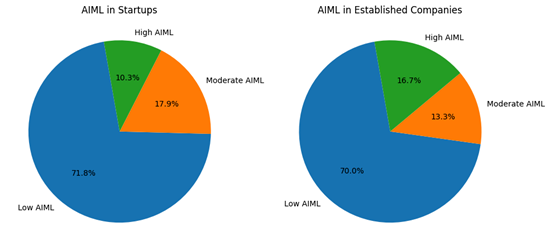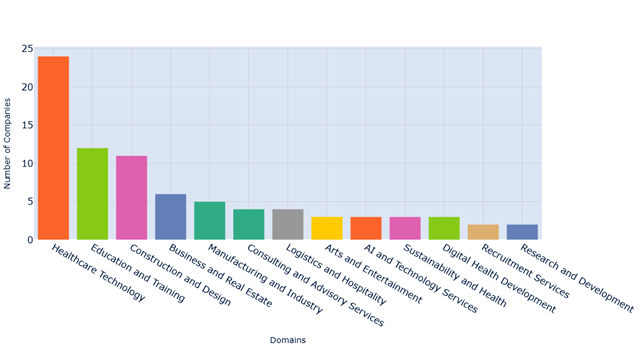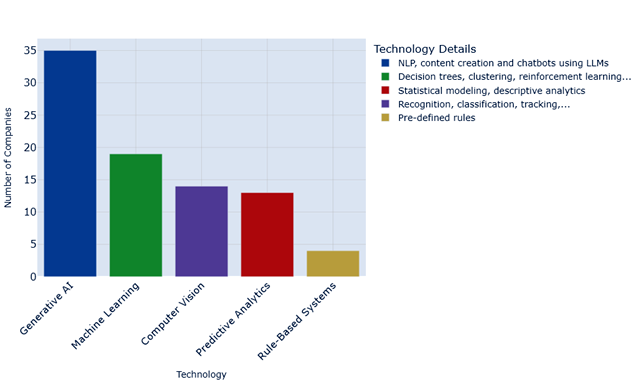

Analysis: AI Adoption Trends in FAIR Customer Companies
Dr Umair Ali Khan, 19.2.2025
As artificial intelligence continues to reshape the business landscape, companies face complex challenges in implementing AI effectively. Through its comprehensive analysis of over 70 European companies’ AI adoption journeys, the Finnish AI Region (FAIR) project reveals critical insights into current trends, challenges, and success factors in AI implementation. This article presents key findings from FAIR’s AI consultancy services, offering valuable perspectives on AI maturity levels, technical expertise requirements, and sector-specific applications across startups and established businesses.
This article presents key findings from FAIR’s AI consultancy services, offering valuable perspectives on AI maturity levels, technical expertise requirements, and sector-specific applications across startups and established businesses.


While businesses worldwide are increasing their investment in AI, effective integration remains a significant challenge. A critical initial step is assessing the feasibility and necessity of AI adoption to create a clear AI roadmap.
To support companies in this process, the Finnish AI Region (FAIR) project provides free AI consultancy for startups, established companies, and technology provider companies to advance their AI capabilities. These services, led by Haaga-Helia University of Applied Sciences in collaboration with FAIR partners, provide tailored guidance to businesses at various stages of their AI adoption journey.
Following each consultancy session, companies receive a detailed feedback report. This report evaluates their proposed AI idea, current solution state, existing AI capabilities, challenges, and requirements. It also includes specific action points and technical recommendations to help guide their next steps effectively.
This article presents key insights based on the analysis of the data from the FAIR AI consultancy. It explores the AI technologies most targeted by companies, the main sectors seeking AI advisory, the link between AI maturity levels and expertise, and the major challenges companies encounter in AI adoption.
FAIR Advisory and its Customer Companies
The FAIR AI advisory process begins with need analysis sessions focused on core technology topics, including technical reviews, AI/ML recommendations, and data services. Each session consists of a one-hour meeting, followed by a feedback report detailing analysis results and recommendations.
In subsequent phases, the advisory extends to independent services covering specific areas such as AI solution assessment, project planning, AI maturity development, data management, and AI regulations. The AI advisory also provides services pertaining to AI-driven transformation, data strategy, proof-of-concept development, and funding application support.
To date, FAIR has offered AI consultancy to over 70 companies, including 56 Finnish, 12 Swedish, 1 Italian, and 1 Scottish company. Of these, 39 are startups, and 31 are established companies. The majority (48) of these companies are at a low AI maturity level, with 12 at moderate and 10 at high maturity levels.
The FAIR AI advisory process begins with need analysis sessions focused on core technology topics, including technical reviews, AI/ML recommendations, and data services. Each session consists of a one-hour meeting, followed by a feedback report detailing analysis results and recommendations.
In subsequent phases, the advisory extends to independent services covering specific areas such as AI solution assessment, project planning, AI maturity development, data management, and AI regulations.

The AI advisory also provides services pertaining to AI-driven transformation, data strategy, proof-of-concept development, and funding application support.
To date, FAIR has offered AI consultancy to over 70 companies which include 56 Finnish, 12 Swedish, 1 Italian, and 1 Scottish company. Of these, 39 are startups, and 31 are established companies. The majority (48) of these companies are at a low AI maturity level, with 12 at moderate and 10 at high maturity levels.
FAIR’s AI advisory supports businesses at various stages of AI integration. Data-as-a-service (DaaS) companies, often lacking in-house AI expertise, focus on data services such as wearable device data and seek AI enhancements for their services. AI startups, having only basic knowledge, often need guidance to refine their concepts. For example, a startup analyzing psychological session data sought technical recommendations to improve their solution.
Established companies new to AI often require a clear roadmap to integrate AI into their operations. For instance, a company needed technical advice to automate the identification of parts in engineering drawings and generate quotations efficiently.
Companies with moderate AI expertise aim to enhance their capabilities with more advanced solutions. For example, a company transitioned from rule-based diagnostics to an AI-driven system that diagnoses simple diseases based on patient responses and generates precise summaries for doctors to review.
Technology (AI) provider companies, who are more experienced with AI, typically focus on scaling their technologies. They often look for services such as computational power, data validation, data collection, or advanced research. For instance, a company developing conversational agents using language models sought guidance on improving data structures to provide more accurate and context-aware answers from company data.
FAIR Customers

Trends in AI Maturity and Technical Expertise Among Companies
AI adoption is increasing across startups and established businesses, with startups representing a significant portion of FAIR’s AI consultancy clients. In FAIR’s AI consultancy, we evaluate companies based on their AI maturity levels (AIML) during need analysis sessions. We categorize these levels into low, moderate, and high.
- Low AIML: These companies are in the early stages of AI integration or development and/or typically in the ideation phase and/or with only a proof of concept. They have limited data, resources, and expertise, and a minimal understanding of AI. AI is minimally or not at all used in workflows, with no data management processes or AI roadmap in place.
- Moderate AIML: These companies are progressing in their AI journey, moving beyond the proof-of-concept stage with functional solutions. They have adequate data, resources, expertise, and understanding of AI. AI is either fully or partially integrated into their workflows, supported by established or developing data management processes, and guided by a partially or fully formulated AI roadmap.
- High AIML: These companies have already developed advanced AI products and have an established customer base. AI is fully or partially integrated into their workflows, supported by established data management processes, and guided by an AI roadmap. They require assistance with specific technical details or when developing new AI applications on top of their existing solutions.
A large proportion of both startups and established companies have low AIMLs which indicates that AI adoption remains in its early stages for many businesses. Even established companies appear slower to adopt AI due to factors such as legacy systems, resistance to change, and the complexity of integrating new technologies into established processes (Alsheiabni et al., 2019). On the contrary, a noticeable proportion of startups have moderate and high AIMLs which reflects their tendency to adopt AI from the outset.

Low technical expertise was found to be strongly associated with low AIMLs, with a large proportion of companies in this category lacking the necessary knowledge and skills to advance AI adoption – a trend consistent with the study by Radhakrishnan et al., (2020). Companies with high technical expertise demonstrate significantly higher AIMLs. AIMLs are more evenly distributed among companies with moderate technical expertise. 54.2% of these companies are at low levels, while 37.5% fall into the moderate category. This highlights the need for targeted guidance to help these companies advance their AI capabilities.

In the FAIR ecosystem, the larger proportion of companies with high technical expertise are established businesses, suggesting that access to resources and industry experience enables these companies to develop in-house AI expertise (Alsheiabni et al., 2019). Startups account for 22.2% of high-expertise companies, indicating that while many begin with limited technical knowledge, they actively work to build expertise as they scale. Similarly, 58.3% of companies with moderate technical expertise are startups, which reflects their efforts to enhance AI maturity as part of their growth strategy – a trend aligned with the findings of Radhakrishnan et al. (2020).

Major Domains of FAIR Customer Companies
Our analysis identifies several key clusters in which FAIR customer companies operate. These sectors include healthcare, education & training, construction & design, business & real estate, manufacturing, and others.
In the healthcare and wellness sector, AI integration requirements include optimizing patient treatment, managing chronic illnesses, offering personalized fitness recommendations, and predicting disease progression, such as heart conditions, sleep apnea, and dementia. They also explore automating documentation, tracking drugs, and analyzing patient sentiments to improve care efficiency and outcomes.
The education and training sector has unique requirements, including AI-based music learning, skill matching in higher education institutions, generating quizzes from educational videos, developing chatbots for immigrant upskilling, enabling AI-driven language learning, and creating personalized lesson plans and goals.
In the construction and design sector, companies require AI solutions for analyzing 3D point cloud images to measure interiors, generating building information models from scanned images, creating house models from recycled materials, scheduling construction tasks, tracking site progress, and drafting construction contracts automatically.
In manufacturing, companies seek automated quotation generation, visual inspection of machine components, and the automatic labeling of objects in 3D images to streamline operations and enhance productivity. Additionally, there is a rising demand across all sectors for integrating company-specific data with language models to answer queries directly from internal documents, improving access to information and facilitating decision-making. These sector-specific examples illustrate how AI is being tailored to meet diverse and practical business challenges.

Major Domains of FAIR Customers
Technologies Required by Companies
A significant portion of FAIR companies are incorporating generative AI, either fully or partially. This aligns with McKinsey’s recent survey (McKinsey 2024), which finds that 65% of organizations are regularly using generative AI. Companies leverage this technology for natural language processing, content creation, and conversational agents powered by language models.
Another prominent trend is the use of traditional machine learning across various applications. These include predicting user inputs for filling online forms with value drivers, forecasting the progression of chronic diseases, adjusting dialysis plans, estimating patient waiting times, and predicting conditions like sleep apnea and strokes. Predictive analytics, based on statistical modeling and descriptive analytics, is also employed in tasks such as optimizing patient treatment, analyzing lifestyle factors’ impact on chronic diseases, examining physiological signals, and predicting treatment outcomes.
Computer vision is another critical area of focus that is being used in applications such as diagnosing heart diseases from cardiac scans, detecting dental diseases from dental images, predicting diseases from cellular images, generating automatic quotations from engineering drawings, detecting electric power lines in 3D point cloud images, automatic target detection and tracking for defense purposes, early prediction of Alzheimer disease by eye movement and identifying objects of interest in images.
“In many cases, we recommended that companies begin with a simple rule-based system before transitioning to an AI-based solution. While these systems are less efficient than AI, they are easier to implement, pose minimal risks, and provide a practical starting point for companies new to AI adoption.“
Some applications still rely on traditional rule-based systems. For example, personalized healthcare plans are often based on pre-defined rules or WHO guidelines. These trends demonstrate the diverse and evolving use of AI technologies across sectors and applications. In many cases, we recommended that companies begin with a simple rule-based system before transitioning to an AI-based solution. While these systems are less efficient than AI, they are easier to implement, pose minimal risks, and provide a practical starting point for companies new to AI adoption.

Major Challenges in AI Adoption
Relevant studies show that many companies often struggle with small datasets, data drift, and sparse AI knowledge, which hinder AI implementation (Luley et al., 2023). A study by Oldemeyer et al., (2024) found the most frequently perceived challenges being knowledge, costs, and IT infrastructure/digital maturity which spanned across economic, social, and technological domains. Addressing the challenges of AI implementation requires a holistic approach. Govori et al., (2023) also list the high costs and technical requirements of AI implementation as main barriers.
These findings align with our observations about technical expertise deficits, especially in model specification, algorithmic requirements, accuracy standards, and tolerance parameters. Many companies struggle with data collection, lacking a valid strategy and means to collect and validate data, unless it is not already collected and archived. There is also a lack of regulatory knowledge related to AI usage and sensitive data processing in certain domains, such as healthcare, where additional security and transparency measures are essential.
Typical, following recurring challenges in adopting were observed.
- Heavy reliance on third-party AI models and services (e.g., OpenAI) available for all developers and using those “as-is” without incorporating them into a novel service. The lack of novelty makes it difficult for the company to distinguish and find a competitive edge.
- Underestimating the work needed for moving from a prototype to a finalized product, e.g., rigorous testing and evaluations needed by generative AI models that are essentially stochastic and non-deterministic systems.
- Lack of Understanding of real business value: Many companies fall into the trap of following the AI hype, attempting to integrate AI without fully understanding or assessing the actual business value it can deliver. This often leads to mediocre products with limited practical viability, business value, and scalability.
- Unnecessary use of AI: Pushing AI when simpler solutions suffice, often referred to as “doing AI for the sake of AI“, can be counterproductive. In many cases, a simple rule-based or statistical model could effectively handle core functionalities without the complexity of AI.
- Inadequate evaluation of AI solutions: Failure to develop and perform proper evaluations for AI solutions in situations and data that match the production conditions. This includes typical issues of training data leakage, where the same data is used in both developing the AI solution and testing its effectiveness, which tends to result in inflated AI performance.
- Lack of co-development approach: Many companies view AI development as solely a technical task for developers. In reality, successful AI adoption requires a multidisciplinary approach involving technical experts, decision-makers, and management. Providing basic AI training to non-technical stakeholders can be useful for their effective contribution and alignment of AI solutions with business goals.
Preparing for Sustainable AI Adoption in a Dynamic Landscape
The successful adoption of AI relies heavily on technical upskilling and a clear understanding of its business value. Companies must focus on getting the right skills to bridge knowledge gaps while identifying areas where AI can truly enhance operations and outcomes
The evolving regulatory landscape, including the upcoming AI Act, poses significant challenges. The AI Act may particularly impact the use of proprietary AI models in Europe and add complexity to AI adoption. Furthermore, companies must remain adaptable, as AI solutions developed today may quickly become obsolete in this rapidly advancing field. The companies will have to keep pace with these changes to maintain competitiveness and relevance.
FAIR advisory plays an important role in supporting businesses through these challenges. By offering tailored guidance, detailed feedback, and actionable recommendations, we help companies tackle the challenges of AI adoption, align their strategies with emerging trends, and future-proof their investments. Our advisory services enable businesses to be well-prepared to thrive in the dynamic and ever-changing AI landscape.
Our future efforts include implementing a newly developed AI maturity model and a competency framework for companies that will provide an assessment of their AI maturity and provide tailored action points and upskilling recommendations along with upskilling packages for individual roles to help them advance their AI capabilities effectively.
Contact

Dr. Umair Ali Khan
Senior Researcher
+358 29 447 1413
umairali.khan@haaga-helia.fi
References
Sulaiman, A., Cheung, Y. & Messom, C. (2019). Factors inhibiting the adoption of artificial intelligence at organizational-level: A preliminary investigation.” Americas Conference on Information Systems. Association for Information Systems.
Radhakrishnan, J. & Chattopadhyay, M. (2020). Determinants and barriers of artificial intelligence adoption–A literature review. Re-imagining diffusion and adoption of information technology and systems: A continuing conversation. IFIP WG 8.6 International Conference on Transfer and Diffusion of IT.
McKinsey & Company. (2024). The state of AI. Retrieved from https://www.mckinsey.com/capabilities/quantumblack/ourinsights/the-state-of-ai
Luley, P., Deriu, J., Yan, P., Schatte, G., & Stadelmann, T. (2023). From Concept to Implementation: The Data-Centric Development Process for AI in Industry. 2023 10th IEEE Swiss Conference on Data Science (SDS), 73-76.
Govori, A., & Sejdija, Q. (2023). Future prospects and challenges of integrating artificial intelligence within the business practices of small and medium enterprises. Governance & Regulation, 10.
Oldemeyer, L., Jede, A., & Teuteberg, F. (2024). Investigation of artificial intelligence in SMEs: a systematic review of the state of the art and the


Finnish AI Region
2022-2025.
Media contacts